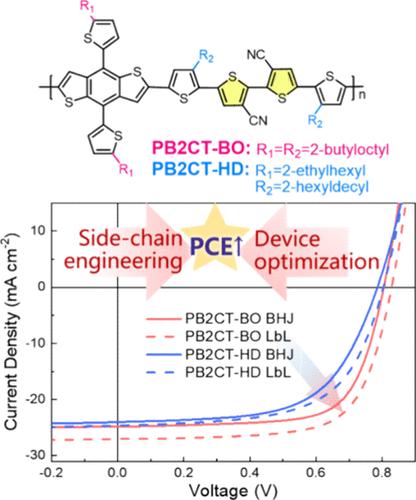Halogen-Free Wide Band Gap Polymer Donors Based on Dicyanobithiophene for Efficient Organic Solar Cells
IF 8.3
2区 材料科学
Q1 MATERIALS SCIENCE, MULTIDISCIPLINARY
引用次数: 0
Abstract
Conjugated polymer donors have always been one of the important components of organic solar cells (OSCs), particularly those featuring simple synthetic routes, proper energy levels, and appropriate aggregation behavior. In this work, we employed a nonfused electron-deficient building block, dicyanobithiophene (2CT), for constructing high-performance donors. Combining this with side-chain engineering, two novel halogen-free polymer donors, PB2CT-BO and PB2CT-HD, were reported. PB2CT-BO with shorter alkyl chains on the thiophene π bridges exhibited enhanced packing ordering and improved polymer crystallinity. When paired with BTP-CN-HD as the electron acceptor, the PB2CT-BO-based OSC attained an impressive power conversion efficiency (PCE) of 14.2% within a bulk-heterojunction (BHJ) configuration. Additionally, the active layers were refined through a layer-by-layer (LbL) approach, leading to a more organized molecular packing and an improved fibrillar network. Consequently, the OSC employing PB2CT-BO processed with the LbL approach achieved a notable PCE of 15.3%. This enhancement is credited to a reduced energy loss (Eloss) of 0.514 eV and the formation of a favorable morphology. This study highlights the considerable promise of the 2CT unit in the progression of high-efficiency polymer donors with a reduced Eloss.

高效有机太阳能电池中基于双氰噻吩的无卤宽禁带聚合物供体
共轭聚合物给体一直是有机太阳能电池(OSCs)的重要组成部分之一,特别是那些合成路线简单、能级合适、聚集行为合适的有机太阳能电池。在这项工作中,我们采用了一种非熔合的缺电子构建块,二氰噻吩(2CT),用于构建高性能供体。结合侧链工程,报道了两种新型无卤聚合物给体,PB2CT-BO和PB2CT-HD。在噻吩π桥上具有较短烷基链的PB2CT-BO具有增强的堆积有序性和改善的聚合物结晶度。当与BTP-CN-HD配对作为电子受体时,pb2ct - bo基OSC在块状异质结(BHJ)结构中获得了令人印象印象的14.2%的功率转换效率(PCE)。此外,活性层通过一层一层(LbL)的方法进行细化,导致更有组织的分子包装和改进的纤维网络。因此,采用LbL方法处理PB2CT-BO的OSC获得了15.3%的显著PCE。这种增强归功于降低了0.514 eV的能量损失(Eloss)和形成了有利的形态。这项研究强调了2CT装置在减少损耗的高效聚合物供体开发中的巨大前景。
本文章由计算机程序翻译,如有差异,请以英文原文为准。
求助全文
约1分钟内获得全文
求助全文
来源期刊

ACS Applied Materials & Interfaces
工程技术-材料科学:综合
CiteScore
16.00
自引率
6.30%
发文量
4978
审稿时长
1.8 months
期刊介绍:
ACS Applied Materials & Interfaces is a leading interdisciplinary journal that brings together chemists, engineers, physicists, and biologists to explore the development and utilization of newly-discovered materials and interfacial processes for specific applications. Our journal has experienced remarkable growth since its establishment in 2009, both in terms of the number of articles published and the impact of the research showcased. We are proud to foster a truly global community, with the majority of published articles originating from outside the United States, reflecting the rapid growth of applied research worldwide.
 求助内容:
求助内容: 应助结果提醒方式:
应助结果提醒方式:


